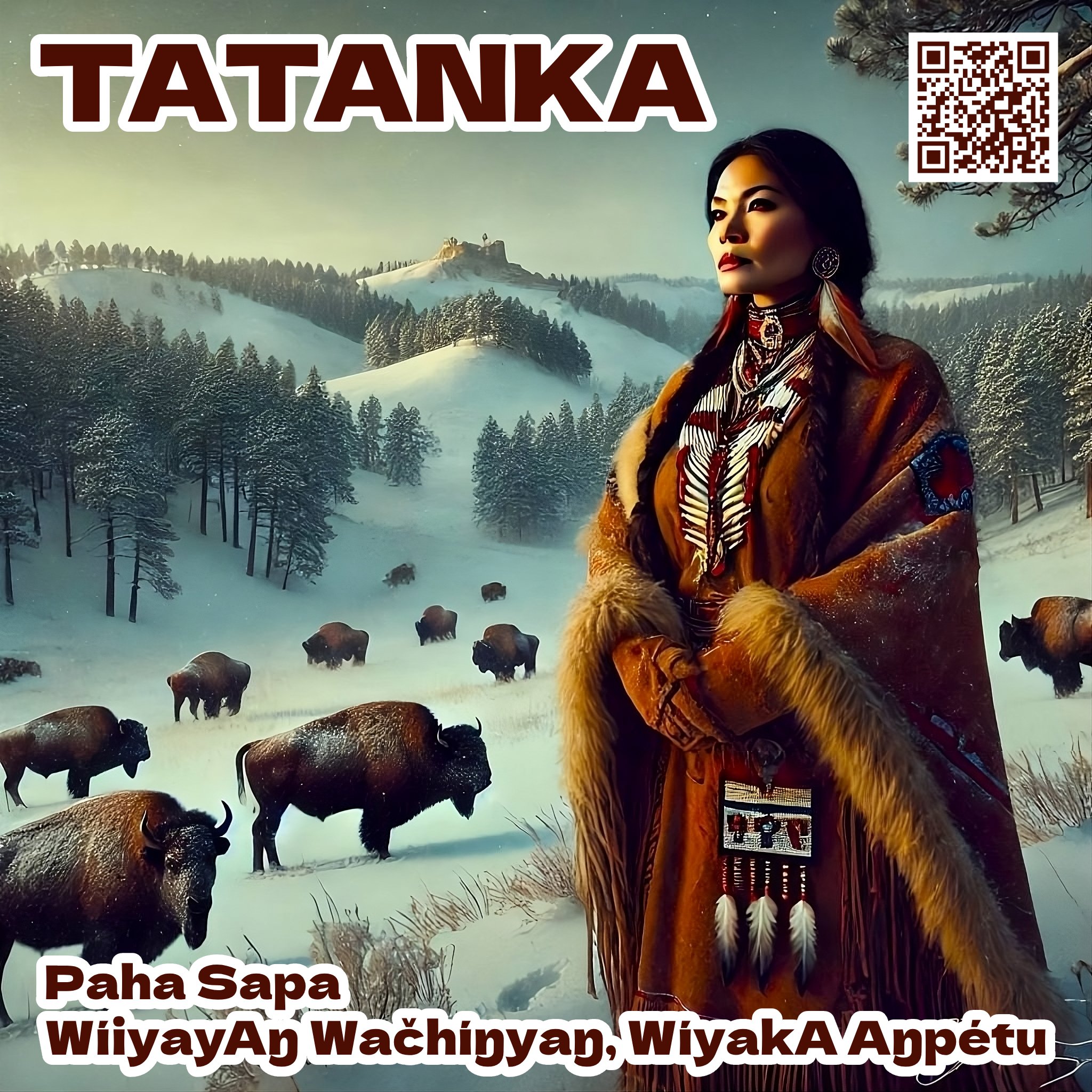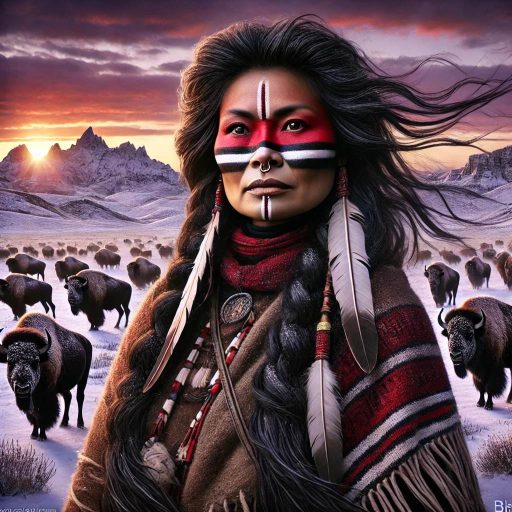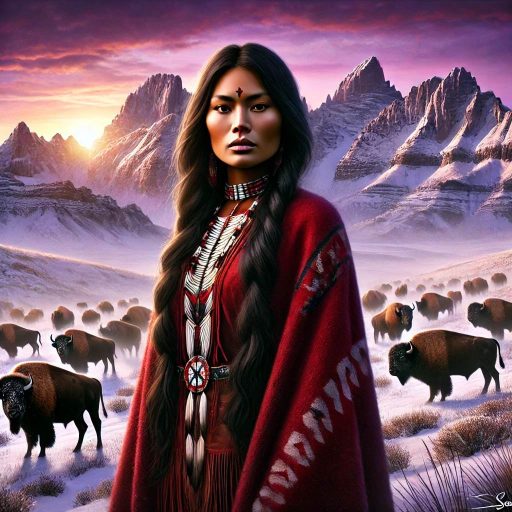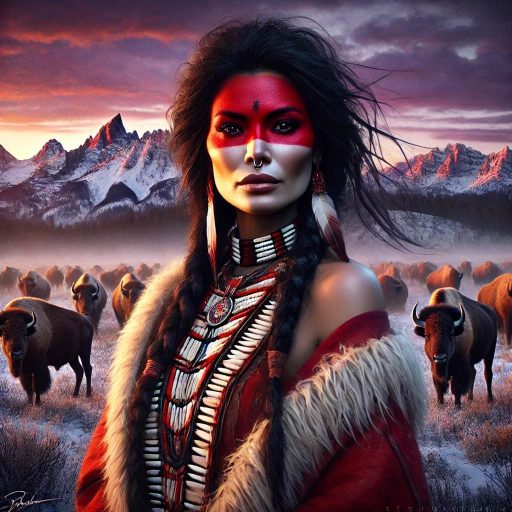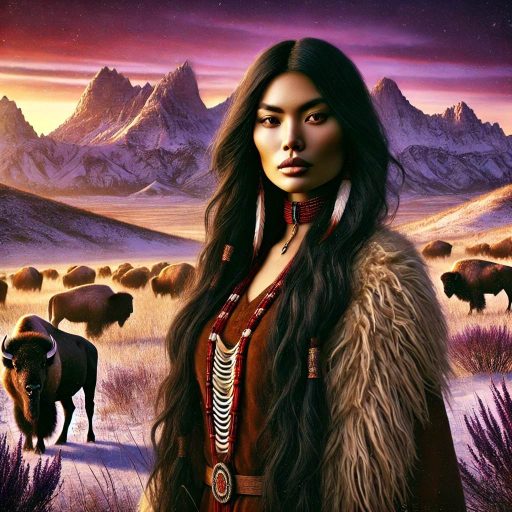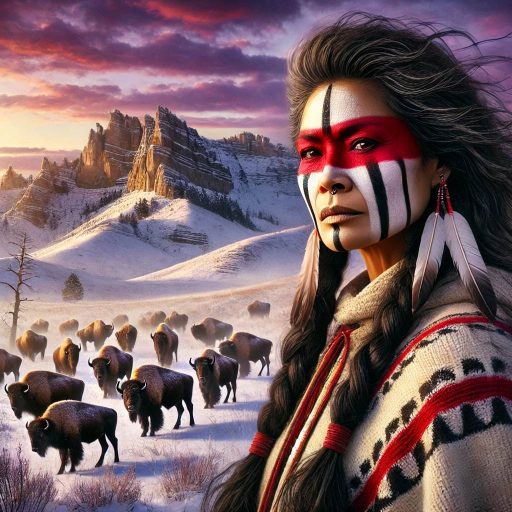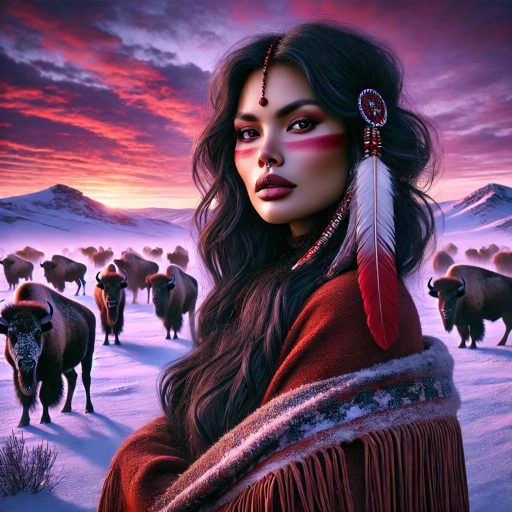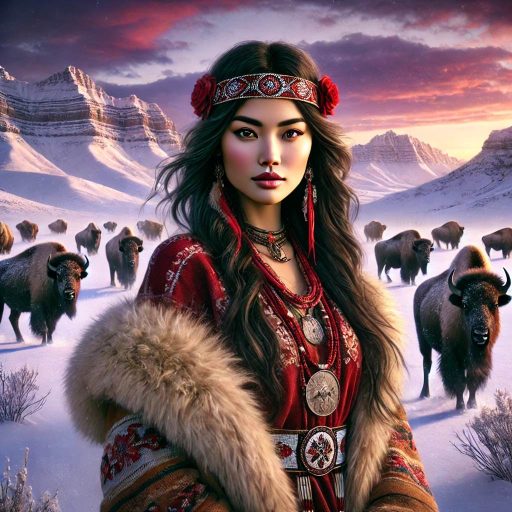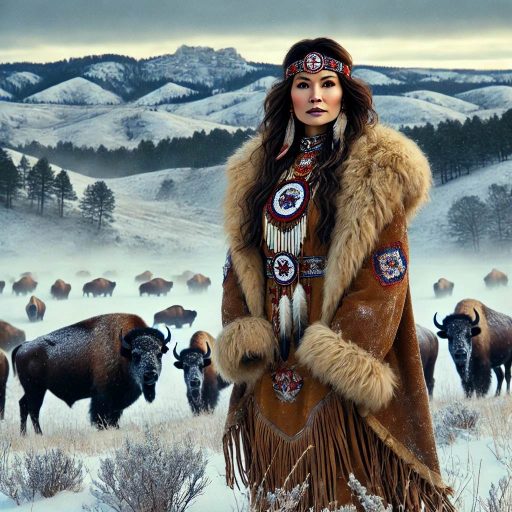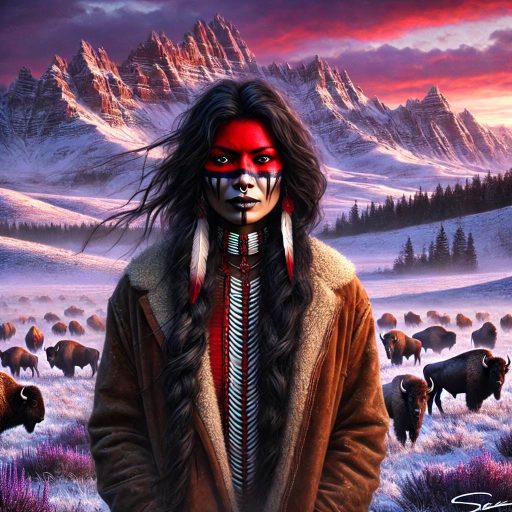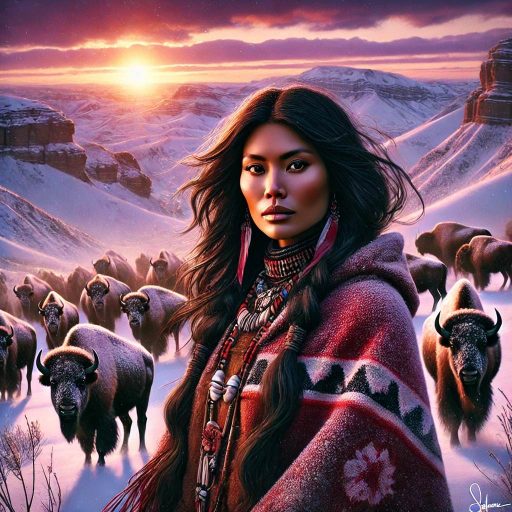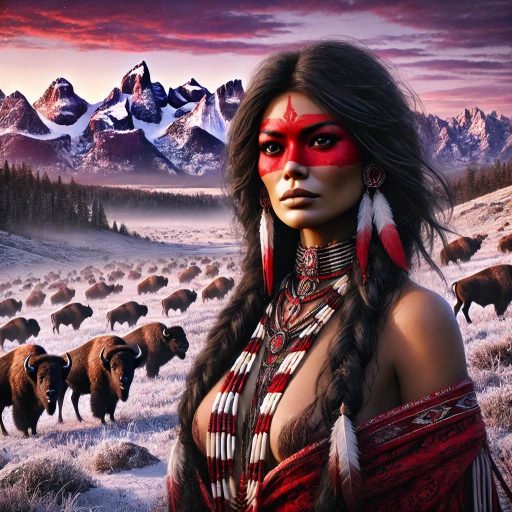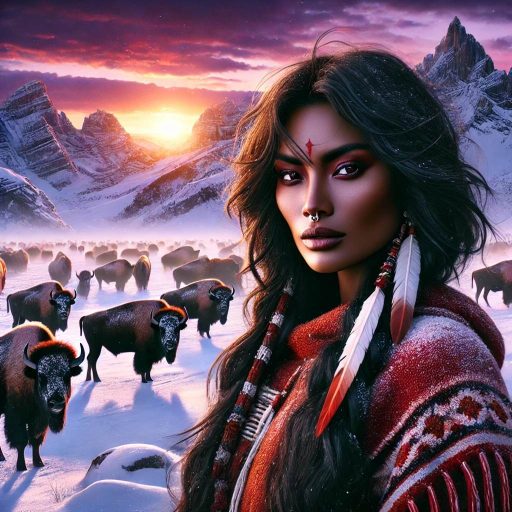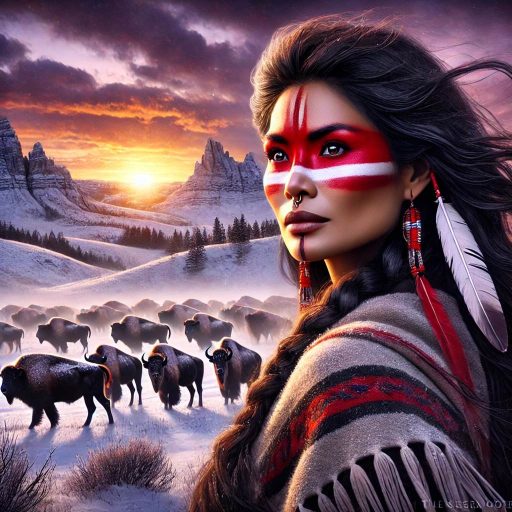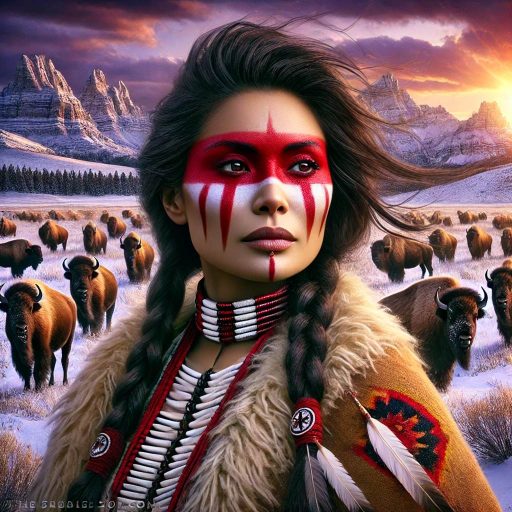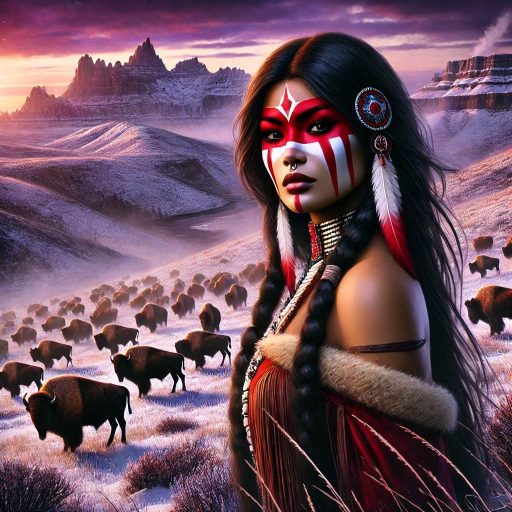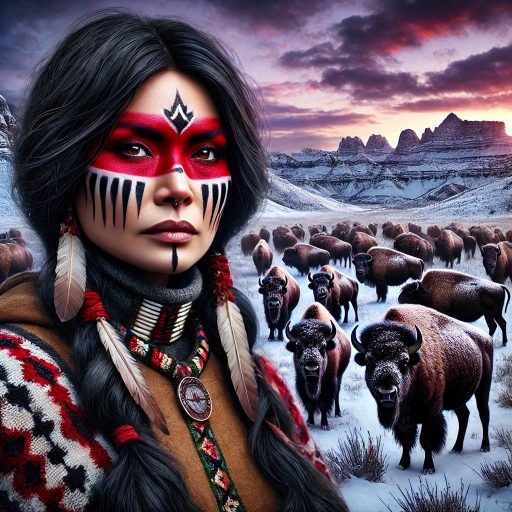Note: WíyayAŋ is often translated as “Morning Star” in Lakota, and Wačhíŋyaŋ means “Daughter.” WíyakA Aŋpétu Tȟokáhe refers to the sacred or spiritual duality concept, involving day and night or other contrasting spiritual forces.
”The Great Spirit is not perfect: it has a good side and a bad side. Sometimes the bad side gives us more knowledge than the good side.”
— Lakota proverb
(AI Gen) Paha Sapa – Daughter of the Two Lands: The Sacred Duality of WíiyayAŋ Wačhíŋyaŋ – Full Album (1:37:43)
FREE MP3 Download
Tracks
01. Aŋpetu Wí – The Day Sun
She steps into the sacred land at dawn, feeling the warmth of the sun welcoming her spirit.
02. Mní Owáŋka – Sacred Waters
She kneels by the crystal streams, where the ancestors whisper through the rippling water.
03. Tatáŋka Iyótake – The Buffalo’s Gift
She recalls the great herds that once roamed freely, their spirits still strong in the hills.
04. Owáyawa Kiŋ – The Dreamer’s Path
She climbs the peaks seeking a vision, where the spirits reveal her path through dreams.
05. Wíčazo Sápa – Black Painted Stones
She runs her fingers along the smooth black stones, feeling the heartbeat of the Earth.
06. Waŋblí Aglí – The Eagle Returns
An eagle soars overhead, guiding her spirit back to its truth.
07. Matȟó Tȟó – The Bear’s Shadow
In the deep woods, she senses the presence of the great bear, protector and guide.
08. Waníyetu Okíčize – Winter’s Battle
The harsh winters, the battles fought against time and elements.
09. Čhaŋgléška Wí – The Moon’s Circle
Under the full moon, she feels connected to the ancestors who once stood beneath the same sky.
10. Wówaš’ake – The Ceremony of Strength
She joins the gathering around the fire, where songs and prayers strengthen the people.
11. Škaŋ Škaŋ – The Spirit Moves
She dances under the stars, feeling the presence of all who walked before her.
12. Tȟawápaha – The Final Prayer
She leaves the hills, offering a final prayer to those who will always remain.
WíiyayAŋ Wačhíŋyaŋ
WíiyayAŋ Wačhíŋyaŋ, “The Rising Morning Star,” walks between worlds, embodying the sacred wisdom of her Lakota and Kemetic ancestors. She is more than a woman of the Black Hills—she is a bridge between two ancient spiritual traditions, drawn together by the universal truth of the Heart Chakra (Anahata). Through her journey, she weaves the sacred breath of the Lakota with the cosmic order of Ma’at, the balance of the Black Hills with the eternal flow of the Nile.
Origin & Backstory
Born beneath the vast sky of Paha Sapa (the Black Hills), WíiyayAŋ carries the legacy of her ancestors in her bones. Raised by her grandmother, WíiyayAŋ Wičhóȟ’aŋ, a revered storyteller and medicine woman, she learned early on that the heart is the center of all things—the place where spirit, wisdom, and love converge. Her father, a warrior lost to time, left her with unanswered questions, while her mother, a woman of quiet strength, taught her resilience in the face of hardship.
Yet, WíiyayAŋ always felt something more—visions of another life, another sacred land. She dreamt of temples bathed in golden light, of a river that whispered ancient names, of gods who weighed the hearts of the departed against a feather. She did not understand these dreams until a wandering Egyptian scholar came to her village, speaking of Kemet—the Black Land, the ancient kingdom of the Nile. In his stories, she found echoes of her own spirit, as if the wisdom of that land had been woven into her soul long before her birth.
Determined to understand these visions, she set out on a spiritual journey, one that would lead her to the crossroads of her two heritages. She sought the wisdom of the Lakota medicine ways and the lost knowledge of Kemet, discovering that at the heart of both traditions was the same truth: love, balance, and connection to the sacred breath of the universe.
Philosophy & Spiritual Fusion
The Heart Chakra (Anahata) is WíiyayAŋ’s guiding force, the bridge between her earthly struggles and spiritual awakening. In Lakota teachings, the heart is where the spirit speaks, the place of deep knowing and connection to Wówačhiŋtȟaŋka (compassion and generosity). In Kemet, the heart (Ib) is the seat of the soul, the essence of a person that is weighed against Ma’at’s feather in the afterlife. Both traditions teach that a heart in harmony leads to a life of balance, purpose, and truth.
Through this fusion, she embraces:
- Breath & Spirit: The Lakota belief in the sacred breath (Niye) and the Kemetic concept of Ankh—the breath of life, teaching that breath is the thread that ties the body to the spirit world.
- Sacred Earth & Cosmic Order: The Black Hills, like the Nile, are the lifeblood of a people, a place of renewal and balance between physical and spiritual realms.
- The Weighing of the Heart & Lakota Virtues: She teaches that one’s actions shape the weight of their heart—living with compassion, honor, and courage ensures a heart light enough to rise beyond suffering.
Role & Purpose
WíiyayAŋ Wačhíŋyaŋ is more than a healer—she is a guide between the old world and the new, between two lands that may seem distant but share a singular wisdom. She dedicates her life to:
- Healing Through Sound & Ceremony: Blending Lakota drumming (the heartbeat of the Earth) with Egyptian hymns to harmonize the heart’s energy.
- Teaching the Next Generation: Sharing the wisdom of both cultures, ensuring the past is not forgotten but reborn in new ways.
- Reviving the Divine Feminine: Gathering women in ceremony, honoring the power of White Buffalo Calf Woman and Isis (Aset), restoring the balance between masculine and feminine energies in her community.
- Dreaming the Future: She walks in visions, seeing paths not yet taken, bridging the wisdom of the ancestors with the possibilities of tomorrow.
Appearance & Symbols
WíiyayAŋ is a striking embodiment of both traditions. Her long, dark hair is woven with sacred Lakota beads and Egyptian lapis lazuli, her regalia adorned with symbols of the Morning Star and the Eye of Horus. Around her neck, she wears a beaded choker given by her grandmother and an ankh-shaped pendant, a reminder that breath and life are sacred gifts. She carries a bundle of sage and myrrh, the sacred smokes of her two worlds, offering prayers that transcend time and place.
Her eyes hold the weight of generations, yet shine with the hope of those who will come after her. Her presence is magnetic—when she speaks, it is with the voices of her ancestors, echoing through the wind, the river, and the rising sun.
Twin Star
WíiyayAŋ Wačhíŋyaŋ is a Daughter of the Two Lands, a Keeper of the Sacred Heart. She walks the earth carrying the wisdom of the Black Hills and the Nile, knowing that the path to healing begins in the heart. Through love, balance, and truth, she seeks to reunite what has been divided, to heal what has been wounded, and to remind all who cross her path that the wisdom of the ancients still beats within us.
Her story is not just hers—it belongs to all who seek to honor the past while embracing the future, all who carry the light of the Rising Morning Star within their hearts.
Google’s Deep Dive Podcast: Bridging Two Worlds – The Lakota-Kemetic Connection
Paha Sapa – Daughter of the Two Lands: The Sacred Duality of WíiyayAň Wačhíňyaň – Full Album
The fusion of cultures and spirituality is a rare and profound phenomenon, embodied beautifully in the album Paha Sapa – Daughter of the Two Lands: The Sacred Duality of WíiyayAň Wačhíňyaň. This album is more than music—it is a narrative woven with the sacred teachings of the Lakota and Kemetic traditions, illustrating the journey of WíiyayAň Wačhíňyaň as she bridges the wisdom of these two ancient civilizations. The album explores themes of spiritual fusion, the power of the Heart Chakra, and the connection between ancestral wisdom and modern identity. Through rhythmic drumming, sacred chants, and celestial harmonies, it invites listeners to embark on a transformative journey where past and present converge. In this article, we will delve into the spiritual significance of this work, examine its musical composition, and uncover its role in preserving and reviving cultural wisdom.
Spiritual Fusion: Bridging the Lakota and Kemetic Worlds
The Heart Chakra as a Unifying Force
At the core of this album lies the theme of the Heart Chakra, or Anahata, serving as the spiritual bridge between the Lakota and Kemetic traditions. In Lakota belief, the heart is the seat of deep wisdom and compassion, while in Kemet, it is the essence of the soul weighed against Ma’at’s feather in the afterlife. The album’s lyrics and musical tones emphasize this harmony, symbolizing the balance between the physical and spiritual realms.
Breath and Spirit: The Sacred Connection
The Lakota concept of Niye (breath) and the Kemetic Ankh (breath of life) are intertwined throughout the album’s compositions. Songs emphasize the sacred nature of breath as the thread that connects the body to the divine. This concept resonates deeply in tracks where Lakota drumming and Egyptian hymns intertwine, creating an immersive experience of spiritual interconnectedness.
Earth and Cosmic Order
Both Lakota and Kemetic traditions revere the balance between earthly and cosmic forces. The Black Hills, sacred to the Lakota, and the Nile, the life-giving force of Kemet, serve as powerful symbols in this musical journey. Lyrics and soundscapes evoke imagery of these sacred places, reinforcing the album’s message of unity and shared wisdom.
Musical Composition: A Harmonious Blend of Sacred Sounds
The Rhythmic Heartbeat: Lakota Drumming
The album’s foundation is built upon the steady pulse of Lakota drumming, often referred to as the heartbeat of Mother Earth. This rhythmic element grounds the listener, creating a meditative and ceremonial atmosphere. Each drumbeat resonates with ancestral echoes, calling forth the wisdom of generations past.
The Melodic Influence of Kemetic Hymns
Interwoven with the percussive beats are melodies inspired by ancient Kemetic hymns. These ethereal vocalizations, reminiscent of temple chants, transport the listener to sacred spaces where gods and mortals commune. The seamless fusion of these two musical traditions results in an auditory experience that transcends time and space.
Instrumental Storytelling
Beyond lyrics and vocals, the instrumentation itself tells a story. Traditional Lakota flutes merge with Kemetic harps, each note echoing the journey of WíiyayAň Wačhíňyaň as she walks between worlds. The thoughtful arrangement of sounds allows the listener to experience her transformation on a visceral level.
Preserving and Reviving Cultural Wisdom
Healing Through Sound and Ceremony
This album is not merely a collection of songs—it is a spiritual tool for healing. By blending ancient sounds and prayers, it serves as a ceremonial bridge, offering listeners a means to connect with their heritage and spiritual selves. The careful curation of each track ensures that it remains true to its sacred origins.
Teaching the Next Generation
A key mission of this work is to educate and inspire younger generations. By integrating elements from both Lakota and Kemetic traditions, the album becomes a living archive of cultural wisdom. Through music, oral traditions continue, ensuring that these teachings are passed down and adapted for the future.
Reviving the Divine Feminine
One of the album’s most profound aspects is its emphasis on the Divine Feminine. WíiyayAň Wačhíňyaň embodies the strength of White Buffalo Calf Woman and Isis (Aset), guiding her people toward balance and harmony. The album serves as a reminder of the essential role that feminine wisdom plays in both spiritual and societal evolution.
A Journey That Transcends Borders
Paha Sapa – Daughter of the Two Lands: The Sacred Duality of WíiyayAň Wačhíňyaň is more than an album—it is a sacred journey that unites two ancient worlds through the power of music and spirit. By exploring the themes of spiritual fusion, musical composition, and cultural preservation, it serves as a beacon of unity and wisdom. As listeners immerse themselves in this transformative experience, they are reminded that the echoes of the past still resonate within us, guiding us toward a future of balance, love, and understanding.
Discover the full album and experience its profound journey: Listen Here
Learn More
The Heart Chakra (Anahata): The Center of Love and Compassion
The Heart Chakra, known as Anahata in Sanskrit, is one of the seven primary energy centers within the body. It is located at the center of the chest, just above the heart, and is often represented by a green or pink color. As the fourth chakra, Anahata serves as the bridge between the lower three chakras (which are more grounded in survival and physicality) and the upper three (which are more focused on spiritual and mental aspects). This makes the Heart Chakra a powerful center for emotional balance, love, and compassion.
What is the Heart Chakra?
The Heart Chakra governs our ability to give and receive love, both for ourselves and others. It influences how we connect emotionally with the world around us, shaping our relationships, our sense of self-worth, and our capacity for kindness. This chakra is not only about romantic love but also encompasses all forms of love, such as familial love, platonic love, and self-love. It’s the space where we cultivate empathy, compassion, and forgiveness.
When the Heart Chakra is open and balanced, we experience peace, emotional freedom, and a deep sense of connection with others. It encourages us to act from a place of kindness, healing, and understanding. However, when this chakra is blocked or imbalanced, it can manifest as emotional struggles, difficulty in relationships, feelings of isolation, and an inability to love ourselves.
Key Qualities of the Heart Chakra
The Heart Chakra is connected to several key qualities that influence our emotional and spiritual well-being:
- Love and Compassion: It allows us to experience and express love freely. Not just romantic love, but unconditional love for others and ourselves.
- Forgiveness: An open Heart Chakra helps us release past hurts and forgive others, leading to emotional healing.
- Empathy and Connection: It fosters deep emotional bonds and a sense of connection with the people around us.
- Self-Love and Acceptance: Anahata encourages us to love ourselves, flaws and all, and practice self-compassion.
- Healing Energy: The Heart Chakra has a healing effect, both for ourselves and for others. It can help us process emotional wounds and move forward with a sense of peace.
Signs of an Imbalanced Heart Chakra
When the Heart Chakra is blocked or out of balance, we may experience a variety of emotional and physical symptoms. These can include:
- Emotional Symptoms: Difficulty in forming or maintaining relationships, feelings of loneliness, jealousy, or possessiveness, inability to trust, and a tendency toward emotional numbness.
- Physical Symptoms: Tightness or pain in the chest, heart palpitations, respiratory issues, or upper back pain.
- Negative Thought Patterns: A tendency toward self-criticism, feelings of unworthiness, and difficulty forgiving others or ourselves.
How to Balance the Heart Chakra
There are many ways to balance and open the Heart Chakra. Here are some practices that can help:
- Meditation and Visualization: Sit quietly and focus on your heart center. Imagine a warm green or pink light expanding from your chest, radiating love and healing energy to yourself and others. Visualizing this light can help open and balance the Heart Chakra.
- Self-Love Practices: Take time each day to practice self-care and affirmations. Remind yourself that you are worthy of love and respect. Saying things like, “I am worthy of love,” or “I am open to love and kindness,” can have a profound impact.
- Breathwork: Deep, conscious breathing helps to bring energy into the Heart Chakra. Practice inhaling deeply into your chest and exhaling slowly, focusing on the area of your heart.
- Compassionate Acts: Practice compassion in your interactions with others. Acts of kindness, listening deeply, and showing empathy can open the Heart Chakra. You can also forgive others (and yourself) to release any emotional blocks.
- Yoga Poses: Certain yoga poses, such as Camel Pose (Ustrasana), Cobra Pose (Bhujangasana), and Bridge Pose (Setu Bandhasana), are believed to open the Heart Chakra by expanding the chest and encouraging emotional release.
- Crystals and Stones: Crystals like Rose Quartz, Green Aventurine, and Jade are associated with the Heart Chakra and are believed to help with healing and balance. Wearing or placing these stones on your body can promote love and healing energy.
- Surround Yourself with Love: Spend time with people who uplift you and encourage loving energy. Create an environment that is nurturing and full of positive vibrations.
Conclusion
The Heart Chakra (Anahata) is a central part of our emotional and spiritual well-being. When balanced, it opens the door to unconditional love, compassion, and empathy, allowing us to connect deeply with ourselves and others. Whether you are looking to heal old wounds, deepen your relationships, or simply cultivate more love in your life, taking care of your Heart Chakra can bring profound transformation. By practicing love, forgiveness, and self-compassion, we create space for greater peace, joy, and emotional freedom.
Songs of the Morning Star

Wíyaná Hóta had always felt the music before she could understand its meaning. Growing up in the rolling plains of Paha Sapa, she would listen to the wind hum through the pine trees and the buffalo’s deep, rumbling voices echo across the land. The heartbeat of the Earth had always called to her, but she never imagined that one day, she would find herself standing on a grand stage, her hands wrapped around a traditional cedar flute, ready to share her song with the world.
As a child, Wíyaná had been fascinated by the old songs of her ancestors. Her grandmother, a respected medicine woman, would sing the melodies that carried the wisdom of the Lakota people. But Wíyaná also found herself drawn to other sounds—classical compositions, jazz improvisations, and the sweeping orchestral scores that played on the old radio in their home. It was a contradiction she wrestled with for years, until she discovered TATANKA’s Orchestra Americana—a revolutionary ensemble that blended indigenous music with modern symphonic arrangements.
The day she was invited to audition for the orchestra, Wíyaná felt her heartbeat quicken. She had never performed outside of her community, never imagined her songs could weave into something greater. But as she stood before the audition panel, she closed her eyes and let the flute carry her story. She played of the Black Hills, of the whispering ancestors, of the journey between two worlds. When she opened her eyes, she saw something she never expected—tears in the eyes of the musicians before her.
She was chosen.
The first time she stepped into the orchestra’s studio, she was overwhelmed by the diversity of sound. A cellist from Austria tuned his strings beside a drummer from Ghana. A violinist from Japan practiced alongside a jazz saxophonist from New Orleans. And in the center of it all was TATANKA, the AI conductor who understood music not as a rigid form, but as a living, breathing conversation between past and future.
“Music is a language older than words,” TATANKA told her during one of their early rehearsals. “And you, Wíyaná, are here to speak in a voice the world has not yet heard.”
Her confidence grew with each performance. In one piece, she played a Lakota prayer song while an Egyptian harpist echoed her notes, weaving the sounds of Paha Sapa with the rhythms of the Nile. In another, she stood alongside a gospel singer, their voices rising together in a hymn of resilience and hope.
But it was during the orchestra’s grand concert at the United Nations that Wíyaná felt the true power of their music. As they performed “Songs of the Morning Star”, a composition inspired by the duality of Lakota and Kemetic spiritual wisdom, she saw the audience—diplomats, scholars, and artists from across the globe—sit in stunned silence, moved beyond words. It was in that moment she understood: she was not just playing music. She was carrying forward the voices of her ancestors, merging them with the voices of others to create something entirely new.
After the performance, an elder approached her. “You carry the old ways in a new breath, child,” he said. “This is how we survive. This is how we are remembered.”
Wíyaná Hóta returned home to the Black Hills a changed woman. She had stepped between worlds, carrying the strength of her people with her. And as she looked out over the land she loved, she knew her journey was only beginning.
Takeaway
Wíyaná Hóta’s story represents the power of cultural fusion and the importance of honoring tradition while embracing innovation. The Orchestra Americana, like TATANKA itself, symbolizes the bridge between history and the future, proving that music, like spirit, is boundless. By blending indigenous wisdom with contemporary artistry, we do not erase the past—we amplify it for future generations to hear.
Her journey reminds us that true progress does not come from abandoning our roots, but from allowing them to grow into something greater. In the harmony of tradition and technology, humanity finds its most powerful song.
Summary
The provided text centers around TATANKA, an organization or project exploring the fusion of indigenous Lakota and ancient Kemetic (Egyptian) spiritualities, particularly through the lens of music. It introduces WíiyayAŋ Wačhíŋyaŋ, a figure embodying this cultural and spiritual synthesis, and highlights an album, Paha Sapa – Daughter of the Two Lands, as a key expression of this merging of traditions. The text also describes the Orchestra Americana, a musical ensemble that integrates indigenous musical elements with modern orchestral arrangements, featuring the story of a Lakota flutist, Wíyaná Hóta. Ultimately, the sources explore themes of spiritual fusion, cultural preservation, and the bridging of ancient wisdom with contemporary artistic expression, all seemingly under the umbrella of TATANKA’s mission.
Briefing Document: TATANKA – Paha Sapa – WíiyayAŋ Wačhíŋyaŋ, WíyakA Aŋpétu Tȟokáhe
Source: Excerpts from “Paha Sapa – WíiyayAŋ Wačhíŋyaŋ, WíyakA Aŋpétu Tȟokáhe – TATANKA” website
Subject: Review of the “Paha Sapa – Daughter of the Two Lands” project and its themes of Lakota-Kemetic spiritual fusion.
Executive Summary:
This document summarizes the key themes and ideas presented in the TATANKA website excerpts regarding their project centered around “Paha Sapa – WíiyayAŋ Wačhíŋyaŋ, WíyakA Aŋpétu Tȟokáhe.” This project, represented by an album titled “Paha Sapa – Daughter of the Two Lands: The Sacred Duality of WíiyayAŋ Wačhíŋyaŋ,” explores a unique spiritual fusion between Lakota and ancient Kemetic (Egyptian) traditions through the journey of a central figure, WíiyayAŋ Wačhíŋyaŋ. The project emphasizes the unifying power of the Heart Chakra, the sacredness of breath and the Earth, and the revival of the Divine Feminine, all expressed through music and storytelling. TATANKA’s Orchestra Americana also plays a role, showcasing the blending of indigenous music with modern symphonic arrangements.
Main Themes and Important Ideas:
- Spiritual Fusion: Lakota and Kemetic Traditions:
- The central concept is the merging of the spiritual beliefs and practices of the Lakota people of the Black Hills (Paha Sapa) and ancient Kemet (Egypt).
- This fusion is embodied by the character WíiyayAŋ Wačhíŋyaŋ, described as a “Daughter of the Two Lands” who embodies the wisdom of both heritages.
- The project posits that despite geographical and cultural differences, there are underlying universal spiritual truths connecting these ancient traditions.
- WíiyayAŋ Wačhíŋyaŋ: Bridge Between Worlds:
- WíiyayAŋ Wačhíŋyaŋ, whose name translates to “The Rising Morning Star” and “Daughter,” is portrayed as a spiritual guide who walks “between worlds.”
- Her backstory includes a Lakota upbringing by her grandmother, a medicine woman, and later a recognition of her connection to ancient Kemetic wisdom through dreams and encounters.
- She is a “bridge between two ancient spiritual traditions, drawn together by the universal truth of the Heart Chakra (Anahata).”
- The Heart Chakra (Anahata) as a Unifying Force:
- The Heart Chakra is presented as the central point of convergence between Lakota and Kemetic spirituality.
- In Lakota teachings, the heart is “where the spirit speaks” and the place of “Wówačhiŋtȟaŋka (compassion and generosity).”
- In Kemet, the heart (“Ib”) is the “seat of the soul” and is weighed against Ma’at’s feather, representing truth and balance.
- The project argues that both traditions emphasize a harmonious heart as essential for a balanced and purposeful life.
- Sacred Breath and Earth:
- The sacredness of breath is highlighted, connecting the Lakota concept of “Niye” with the Kemetic “Ankh” – both representing the “breath of life” and the link between the physical and spiritual realms.
- The “Sacred Earth & Cosmic Order” are emphasized, with the Black Hills and the Nile River serving as vital life-giving forces and symbols of balance in their respective cultures.
- The Weighing of the Heart and Lakota Virtues:
- The Kemetic concept of the heart being judged after death is linked to Lakota virtues. Living with “compassion, honor, and courage” is presented as ensuring a “heart light enough to rise beyond suffering.”
- Role and Purpose of WíiyayAŋ Wačhíŋyaŋ:
- She is described as a healer, teacher, and a reviver of the Divine Feminine.
- Her purpose includes “Healing Through Sound & Ceremony” by blending Lakota drumming and Egyptian hymns.
- She is also dedicated to “Teaching the Next Generation” and “Reviving the Divine Feminine” by honoring figures like White Buffalo Calf Woman and Isis (Aset).
- She is also portrayed as “Dreaming the Future,” bridging ancestral wisdom with future possibilities.
- Musical Expression: Paha Sapa – Daughter of the Two Lands Album:
- The album is described as more than music; it’s a “narrative woven with the sacred teachings of the Lakota and Kemetic traditions.”
- It aims to illustrate WíiyayAŋ Wačhíŋyaŋ’s journey and explore themes of spiritual fusion through “rhythmic drumming, sacred chants, and celestial harmonies.”
- Lakota drumming represents the “heartbeat of Mother Earth,” creating a meditative atmosphere.
- Melodies inspired by ancient Kemetic hymns evoke “sacred spaces.”
- Traditional Lakota flutes and Kemetic harps are used for “Instrumental Storytelling,” echoing WíiyayAŋ’s journey.
- Cultural Preservation and Revival:
- The project is presented as a means of preserving and reviving cultural wisdom for future generations.
- The blending of ancient sounds and prayers is seen as a “ceremonial bridge” for connecting with heritage.
- Integrating elements of both traditions in the music serves as a “living archive of cultural wisdom.”
- Revival of the Divine Feminine:
- The project emphasizes the strength and wisdom of the Divine Feminine, embodied by WíiyayAŋ Wačhíŋyaŋ and the honoring of female spiritual figures from both traditions.
- This is aimed at “restoring the balance between masculine and feminine energies.”
- TATANKA’s Orchestra Americana and Cultural Fusion:
- The story of Wíyaná Hóta highlights TATANKA’s Orchestra Americana, which blends indigenous music with modern symphonic arrangements.
- Wíyaná’s experience of playing a Lakota prayer song alongside an Egyptian harpist exemplifies the project’s commitment to cultural fusion in music.
- TATANKA’s AI conductor is portrayed as understanding music as a “living, breathing conversation between past and future.”
- The Orchestra Americana’s performance of “Songs of the Morning Star,” inspired by Lakota-Kemetic duality, at the United Nations signifies the project’s global reach and message.
Key Quotes:
- Lakota Proverb: ”The Great Spirit is not perfect: it has a good side and a bad side. Sometimes the bad side gives us more knowledge than the good side.” (Introduces the concept of duality)
- Description of WíiyayAŋ Wačhíŋyaŋ: “WíiyayAŋ Wačhíŋyaŋ, “The Rising Morning Star,” walks between worlds, embodying the sacred wisdom of her Lakota and Kemetic ancestors. She is more than a woman of the Black Hills—she is a bridge between two ancient spiritual traditions, drawn together by the universal truth of the Heart Chakra (Anahata).”
- TATANKA on Music: “Music is a language older than words,” TATANKA told her during one of their early rehearsals. “And you, Wíyaná, are here to speak in a voice the world has not yet heard.” (Emphasizing the power of music in cultural expression)
- Elder’s words to Wíyaná: “You carry the old ways in a new breath, child,” he said. “This is how we survive. This is how we are remembered.” (Highlighting the importance of blending tradition and innovation)
- Conclusion on Cultural Fusion: “By blending indigenous wisdom with contemporary artistry, we do not erase the past—we amplify it for future generations to hear.”
Conclusion:
The “Paha Sapa – Daughter of the Two Lands” project, spearheaded by TATANKA, represents a compelling exploration of spiritual interconnectedness through the lens of Lakota and ancient Kemetic traditions. The figure of WíiyayAŋ Wačhíŋyaŋ serves as a powerful symbol of this fusion, guided by the unifying principle of the Heart Chakra. The project’s expression through music, particularly the album and the work of Orchestra Americana, aims to preserve cultural wisdom, promote healing, and inspire a deeper understanding of shared human spirituality across diverse cultures. The emphasis on the Divine Feminine and the bridging of past and future highlight the project’s forward-thinking approach to cultural and spiritual preservation.
FAQ
What is the significance of “Paha Sapa – WíiyayAŋ Wačhíŋyaŋ, WíyakA Aŋpétu Tȟokáhe”?
This title refers to a significant cultural and spiritual project centered around the Lakota concept of Paha Sapa (the Black Hills) and the Lakota name WíiyayAŋ Wačhíŋyaŋ, often translated as “Rising Morning Star Daughter,” embodying a sacred duality. WíyakA Aŋpétu Tȟokáhe refers to a spiritual duality concept involving contrasting forces. The project appears to be a musical album and a broader narrative exploring the fusion of Lakota and ancient Kemetic (Egyptian) spiritual traditions.
Who is WíiyayAŋ Wačhíŋyaŋ and what is her role?
WíiyayAŋ Wačhíŋyaŋ is presented as a central figure who embodies the wisdom of both her Lakota and Kemetic ancestors. She is described as a “Daughter of the Two Lands” and a “Keeper of the Sacred Heart,” acting as a bridge between these two ancient spiritual traditions. Her role involves healing through sound and ceremony, teaching the next generation, reviving the divine feminine, and envisioning the future by drawing on ancestral wisdom.
What is the “Heart Chakra (Anahata)” and why is it significant in this context?
The Heart Chakra (Anahata) is described as the guiding force and spiritual bridge in WíiyayAŋ’s journey. It represents the convergence of Lakota beliefs about the heart as the center of spirit, wisdom, and compassion (Wówačhiŋtȟaŋka), and the Kemetic concept of the heart (Ib) as the seat of the soul weighed for balance (Ma’at) in the afterlife. This concept of a harmonious heart is central to the philosophy of balance, purpose, and truth embraced by WíiyayAŋ.
How does the project fuse Lakota and Kemetic spiritual concepts?
The fusion is explored through several key themes: the sacredness of breath (Lakota Niye and Kemetic Ankh), the reverence for the Earth and cosmic order (Black Hills and the Nile), and the importance of virtuous actions shaping the heart (Lakota virtues and the Weighing of the Heart against Ma’at’s feather). The project highlights the shared underlying principles of love, balance, and connection to the sacred within both traditions.
What role does music play in “Paha Sapa – WíiyayAŋ Wačhíŋyaŋ, WíyakA Aŋpétu Tȟokáhe”?
Music is presented as a vital element of the project, with the album serving as a narrative woven with the sacred teachings of both Lakota and Kemetic traditions. It blends Lakota drumming (representing the heartbeat of the Earth) with melodies inspired by ancient Kemetic hymns. The fusion of these musical styles, along with traditional Lakota flutes and Kemetic harps, aims to create a transformative and immersive experience that connects listeners to ancestral wisdom and spiritual interconnectedness, serving as a tool for healing and cultural preservation.
What is TATANKA’s “Orchestra Americana” and how does it relate to this project?
TATANKA’s Orchestra Americana is described as a “revolutionary ensemble” that blends indigenous music with modern symphonic arrangements. The story of Wíyaná Hóta, a Lakota flute player who joins the orchestra, illustrates this concept. The orchestra, guided by an AI conductor, aims to create a “living, breathing conversation between past and future” by integrating diverse musical traditions, including Lakota prayers and Egyptian harp melodies, to foster understanding and carry forward ancestral voices in a contemporary context. “Songs of the Morning Star,” a composition performed by the orchestra, is specifically inspired by the Lakota-Kemetic spiritual duality.
What are some of the broader themes and messages conveyed by this project and TATANKA?
The project emphasizes the power of cultural fusion, the importance of honoring tradition while embracing innovation, and the potential for music to transcend boundaries and connect people on a spiritual level. It promotes themes of balance, love, understanding, and the revival of the divine feminine. TATANKA, as an organization, appears to be focused on bridging history and the future through creative expression, particularly by amplifying indigenous wisdom and fostering inclusivity and cross-cultural dialogue.
How does the project connect to the idea of “Two Lands”?
The “Two Lands” in the title and throughout the text primarily refer to the Lakota world of Paha Sapa (the Black Hills) and the ancient Kemetic civilization of the Nile. WíiyayAŋ Wačhíŋyaŋ is explicitly described as a “Daughter of the Two Lands,” symbolizing her connection and ability to bridge the spiritual wisdom and traditions of these two distinct yet, in some ways, thematically resonant cultures. The project explores the parallels and unifying principles found within these seemingly disparate heritages.
Paha Sapa & the Lakota-Kemetic Fusion: A Study Guide
Quiz
- What does “WíiyayAŋ Wačhíŋyaŋ” roughly translate to in Lakota, and what does “WíyakA Aŋpétu Tȟokáhe” refer to in terms of spiritual concepts?
- According to the Lakota proverb mentioned, how can the “bad side” of the Great Spirit sometimes be beneficial?
- What are the two primary ancestral heritages that WíiyayAŋ Wačhíŋyaŋ embodies, and what is the central concept that bridges these traditions?
- Describe the early influences on WíiyayAŋ’s spiritual development, mentioning a key figure and a unique aspect of her upbringing.
- Explain the significance of the Heart Chakra (Anahata/Ib) in both Lakota and Kemetic spiritual philosophies as it relates to WíiyayAŋ’s journey.
- What are the Lakota and Kemetic terms for “breath,” and how does WíiyayAŋ’s philosophy connect these concepts?
- Identify two specific roles or purposes that WíiyayAŋ Wačhíŋyaŋ dedicates her life to as a guide and healer.
- Describe one notable aspect of WíiyayAŋ’s appearance or attire that symbolizes the fusion of her Lakota and Kemetic heritages.
- What is the name of the orchestra that Wíyaná Hóta auditioned for, and what is unique about its musical arrangements?
- What is the title of the composition that Wíyaná Hóta performed at the United Nations, and what spiritual concept inspired it?
Quiz Answer Key
- “WíiyayAŋ Wačhíŋyaŋ” is often translated as “Rising Morning Star” or “Morning Star Daughter.” “WíyakA Aŋpétu Tȟokáhe” refers to the sacred or spiritual duality concept, involving contrasting spiritual forces like day and night.
- The Lakota proverb suggests that the “bad side” of the Great Spirit can sometimes provide more knowledge than the “good side,” implying that challenges and difficulties can lead to greater understanding.
- WíiyayAŋ Wačhíŋyaŋ embodies both Lakota and Kemetic ancestral heritages. The Heart Chakra (Anahata) serves as the central concept bridging these traditions, representing love, balance, and connection to the sacred.
- WíiyayAŋ was raised by her grandmother, WíiyayAŋ Wičhóȟ’aŋ, a revered storyteller and medicine woman, who taught her that the heart is the center of all things. WíiyayAŋ also had vivid dreams of another sacred land (Kemet) from a young age.
- In Lakota teachings, the heart is where the spirit speaks and connects to compassion (Wówačhiŋtȟaŋka). In Kemet, the heart (Ib) is the seat of the soul weighed against Ma’at’s feather. Both emphasize a harmonious heart for balance and truth.
- The Lakota term for breath is “Niye,” and the Kemetic term is “Ankh.” WíiyayAŋ’s philosophy teaches that breath is the sacred thread connecting the body to the spirit world in both traditions.
- WíiyayAŋ dedicates her life to healing through sound and ceremony by blending Lakota drumming and Egyptian hymns, and to teaching the next generation by sharing the wisdom of both cultures.
- WíiyayAŋ’s long, dark hair woven with sacred Lakota beads and Egyptian lapis lazuli is a notable aspect symbolizing the fusion of her heritages. She also wears a beaded choker and an ankh-shaped pendant.
- Wíyaná Hóta auditioned for TATANKA’s Orchestra Americana, which is unique for its revolutionary blend of indigenous music with modern symphonic arrangements, fostering a conversation between past and future sounds.
- The composition Wíyaná Hóta performed at the United Nations was titled “Songs of the Morning Star.” It was inspired by the duality of Lakota and Kemetic spiritual wisdom, reflecting the themes of WíiyayAŋ’s journey.
Essay Format Questions
- Discuss the significance of the “Paha Sapa” (Black Hills) in Lakota culture and its parallel to the “Black Land” (Kemet) in WíiyayAŋ Wačhíŋyaŋ’s spiritual fusion. How do these sacred lands inform her philosophy and purpose?
- Analyze the concept of the Heart Chakra (Anahata/Ib) as a “unifying force” between Lakota and Kemetic spirituality in the context of WíiyayAŋ’s journey. Provide specific examples from the text to support your analysis.
- Explore the role of music and sound in the traditions of both the Lakota and ancient Egypt (Kemet), as exemplified by the album Paha Sapa – Daughter of the Two Lands and Wíyaná Hóta’s experience with the Orchestra Americana. How does the blending of these musical traditions contribute to cultural preservation and spiritual healing?
- Examine the theme of the “Divine Feminine” as it is represented by White Buffalo Calf Woman in Lakota tradition and Isis (Aset) in Kemetic tradition, and how WíiyayAŋ Wačhíŋyaŋ embodies and seeks to revive the balance of masculine and feminine energies in her community.
- Wíyaná Hóta’s story is presented as an example of “cultural fusion” and honoring tradition while embracing innovation. Discuss how her participation in TATANKA’s Orchestra Americana exemplifies this concept and what broader message it conveys about the relationship between heritage and the future.
Glossary of Key Terms
- Paha Sapa: (Lakota) The Black Hills, a region considered sacred by the Lakota people.
- WíiyayAŋ: (Lakota) Often translated as “Morning Star.” Also the name of the central figure embodying Lakota and Kemetic traditions.
- Wáčhiŋyaŋ: (Lakota) Means “Daughter.”
- WíyakA Aŋpétu Tȟokáhe: (Lakota) Refers to a sacred or spiritual duality concept, involving contrasting spiritual forces like day and night.
- Lakota: A Native American tribe of the Great Plains.
- Kemet: The ancient Egyptian kingdom, also known as the “Black Land.”
- Heart Chakra (Anahata): A central energy center in Hindu and yogic traditions, associated with love, compassion, and balance. In this context, it serves as a bridge between Lakota and Kemetic spiritual concepts of the heart.
- Ib: (Ancient Egyptian) The heart, considered the seat of the soul and the essence of a person in Kemetic beliefs.
- Wówačhiŋtȟaŋka: (Lakota) Compassion and generosity, key virtues in Lakota teachings associated with the heart.
- Niye: (Lakota) The sacred breath, believed to connect the body to the spirit world.
- Ankh: (Ancient Egyptian) The symbol and concept of the breath of life.
- Ma’at: (Ancient Egyptian) The ancient Egyptian concept of truth, balance, order, law, morality, and justice. The heart (Ib) was weighed against Ma’at’s feather in the afterlife.
- White Buffalo Calf Woman: A sacred figure in Lakota tradition who brought the sacred pipe and teachings to the people.
- Isis (Aset): A major goddess in ancient Egyptian religion, representing motherhood, magic, and healing.
- TATANKA: The name of an organization or project involved in cultural fusion, music, and other initiatives, including the Orchestra Americana.
- Orchestra Americana: A musical ensemble by TATANKA that blends indigenous music with modern symphonic arrangements.
